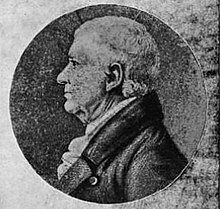William Fitzhugh

William Fitzhugh (August 24, 1741 – June 6, 1809) was an American planter and statesman who served as a delegate to the Continental Congress for Virginia in 1779. [1]
Life
Fitzhugh and his wife, Ann Randolph (1747-1805), built Chatham Manor on property across the Rappahannock River from Fredericksburg, Virginia, between 1768 and 1771. It still stands today as the National Park Service Headquarters for the Fredericksburg and Spotsylvania National Military Park. The Fitzhughs lived a lavish life there that included experimental farming and horse racing. After the Revolutionary War, as the economy floundered, Fitzhugh sold Chatham Manor and 1,288 acres (5.2 km²) to Churchill Jones for $20,000.
About 1799, William Fitzhugh bought the house in 607 Oronoco St., Alexandria, Virginia, that has become known as "The Boyhood Home of Robert E. Lee." The house was built in 1795 by John Potts, Jr. After William Fitzhugh's death, it then passed to William Henry Fitzhugh, his only son, and was rented to the Lee family.
Fitzhugh had built another mansion, Ravensworth, in 1796, where North Springfield, Virginia, is now located. This was his country home, with the Alexandria one being his townhouse. Ravensworth stood until about 1925, when it burned under mysterious circumstances.[2]
William Fitzhugh and George Washington visited one another frequently until Washington's death in 1799. He was the last person that Washington visited outside of Mount Vernon before his death.
Political career
He was chosen as an elector for the 1789 election from Westmoreland District [3]. That District consisted of King George County, Lancaster County, Northumberland County, Richmond County, Stafford County and Westmoreland County, which cover the area between the Rappahannock and Potomac Rivers[4]. All of the 10 electors who voted cast one of their two votes for George Washington. 5 of them cast their other vote for John Adams. 3 cast theirs for George Clinton. 1 cast his for John Hancock. 1 cast his for John Jay [5]. In a letter written by James Madison to Thomas Jefferson on 29th March 1789, 'Mr W Fitzhugh of Chatham' is described as a Federalist [6]
Family
He was the great-grandson of immigrant Colonel William Fitzhugh who came to Virginia in about 1671 and owned 54,000 acres (220 km²) when he died in 1701. William of Chatham inherited most of the land. As a child he suffered the loss of an eye when accidentally hit with a whip by one of his stepbrothers.
In 1804 Fitzhugh's daughter Mary Lee Fitzhugh was married in the parlor of the Alexandria townhouse to George Washington Parke Custis, grandson of Martha Dandridge Custis Washington and adopted grandson of George Washington. In 1831 their daughter, Mary Anna Randolph Custis, married Robert E. Lee.
Fitzhugh died five years later at the age of 69, leaving behind his three children. He was initially buried at Ravensworth, but when the mansion was destroyed, his remains and gravestone were moved to the Pohick Church graveyard.
References
- ^ http://bioguide.congress.gov/scripts/biodisplay.pl?index=F000173
- ^ http://braddockheritage.org/content/vault/Stuntz_Mayo_c092fa2e92.pdf
- ^ The Documentary history of the first Federal elections, 1788-1790, by Gordon DenBoer, Volume 2, page 303
- ^ http://elections.lib.tufts.edu/aas_portal/view-election.xq?id=MS115.002.VA.1789.00027
- ^ The Documentary history of the first Federal elections, 1788-1790, by Gordon DenBoer, Volume 2, pages 304-5
- ^ Cited in 'The Documentary history of the first Federal elections, 1788-1790', by Gordon DenBoer, Volume 2, page 408
